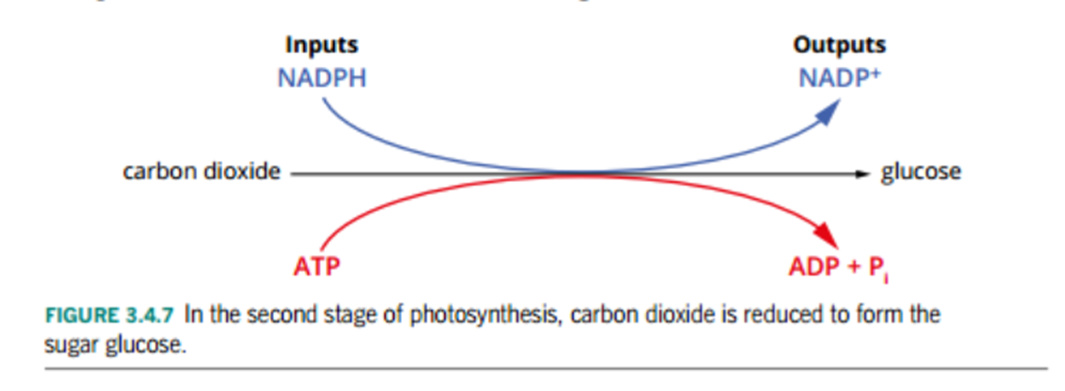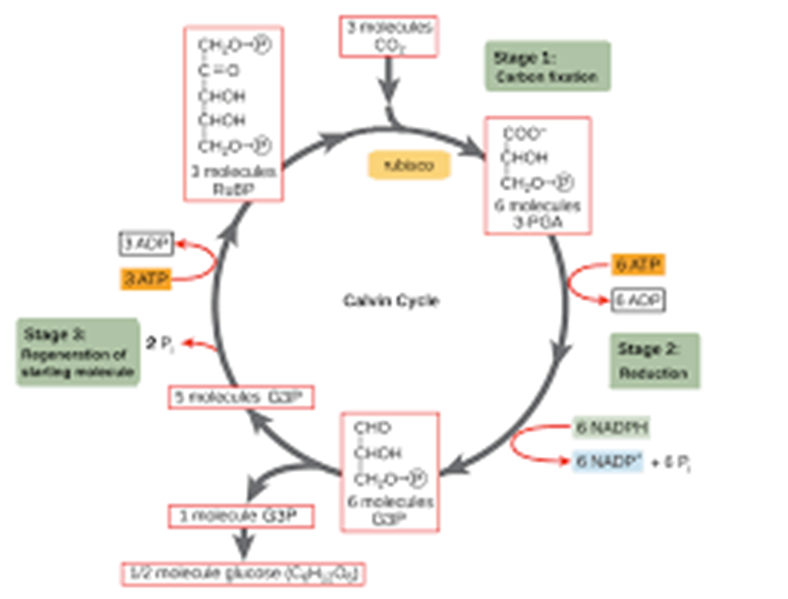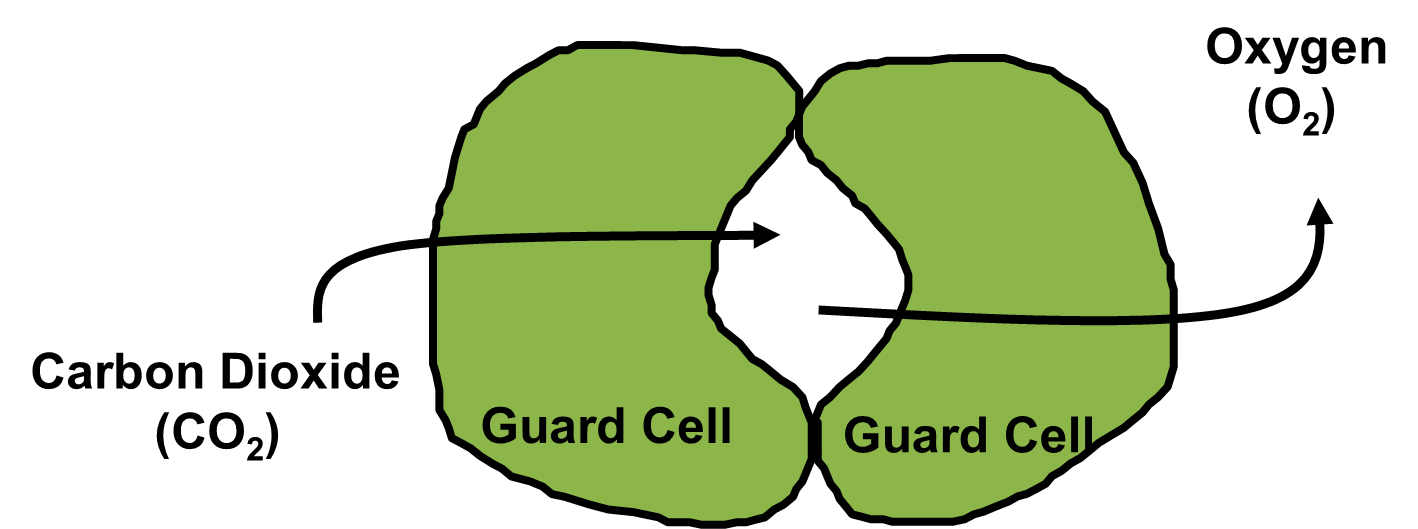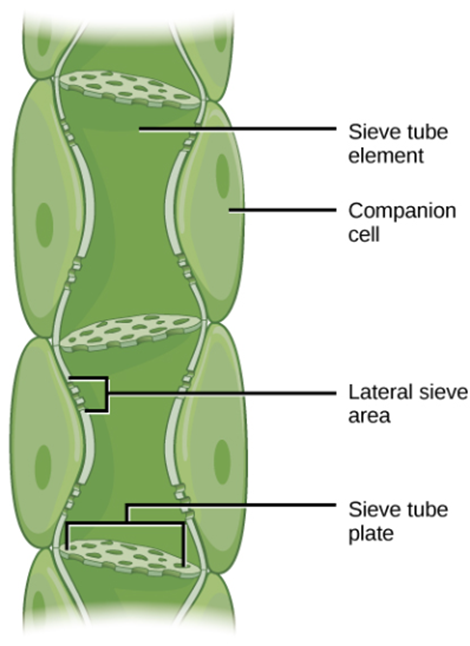1.3: Cellular Energy, Gas Exchange and Plant Physiology
1/19
Name | Mastery | Learn | Test | Matching | Spaced |
|---|
No study sessions yet.
20 Terms
Aerobic Respiration
Takes place in the mitochondria where glucose is broken down and 36-38 mols of ATP is formed.
Anaerobic Respiration
When no oxygen is used so it produces CO2 and lactic acid. less efficient than Areobic respiration and only produces 2 ATP
Stages of Cell Respiration (Aerobic)
The controlled release of energy in the form of Adenosine Triphosphate (ATP) from organic compounds (fat or carbs) in cells.
Cycolysis - 2 ATP in cytoplasm. 1 glucose molecule is halved into 2 pyruvic acid molecules
Krebs Cycle - 2 ATP in the matrix. Pyrivic acid is broken down to CO2 in a series of energy-extracting reactions.
Electron Transport Chain - 32-34 ATP in cristae. Coverting APD to ATP.
Takes place in the mitochondria. 36-38 molecules of Adenosine Triphosphate. (ATP)
Alcoholic Fermentraion
Produces Alcohol and CO2 and is done with yeast
Lactic acid Fermentaion
produced by muscles during rapid exercise when the body can’t supply enough oxygen.
Ventilation
the pumping mechanism of moving air into and out of the lungs
Gas exchange
exchange of gases between an organism and its surroundings. takes place by diffusion.
large surface area (300 million alveoli)
Moist: gases can dissolve and travel easier
Once cell thick
Capillary system
CO2 diffuses from the capillaries into the alveolus
O2 diffuses from the alveolus into the capillaries
Many capillaries allows for high rate of diffusion of gases
Arteries
Function = carry blood away from the heart at high pressure
Structure of wall = thick, strong, contains muscles, elastic fibres and fibrous tissue
Lumen = narrow, varies with heartbeat
Valves = -
How structure fits function = strength and elasticity is needed to withstand the pulsing of the high blood pressure to prevent bursting and maintain pressure
Capillaries
Function = supply all cells with their requirements and take away waste products
Structure of wall = very thin, only one cell thick
Lumen = very narrow, only wide enough for red blood cells to pass through.
Valves = -
How structure fits function = most of the blood pressure has been lost, so the walls aren’t strong. thin walls and narrow lumen allows for the blood to be broughtinto close contact with body tissue which allows diffusion of materials between capillaries and surrounding tissues. White lood cells can squeeze between the cells of the wall.
Veins
Function = Return blood to the heart at low pressure
Structure of wal = thin, mainly fibrou tissue, contains less muscle and elastic tissue than arteries.
Lumen = wide
Valves = + (prevents backflow)
How structure fits function = most of the blood pressure has been lost so the walls don’t need to be strong. Wide lumen offers less resistance to blood flow.
Photosynthesis
Basic carbs in food chain come from Green plants from H2O and CO2, using the sun’s energy.
Plants are producers/autotrophs
An anabloic, endergonic, CO2 requiring process that uses Photons (light energy) and H2O to produce organic macromolecultes (glucose)
Takes place in Chloroplast
6CO2 + 6H2O —> C6H12O6 + 6O2
Light Dependent Reactions
Produces energy from photons in the form of ARP and NADPH. Uses H2O and Produces O2.

Light Independent Reaction
Calvin cycle - Carbon Fixation
Uses CO2 and energy from light dependent reactions to make glucose.

Calvin Cycle
C3 plants (80% of plants on earth)
occurs in the stroma
uses ATP and NADPH from light dependent reactions
Uses CO2
takes 6 turns and uses 18 ATP and 12 NADPH to produce glucose

Stomata (stoma)
Pores in a plants cuticle where water and gases are exchange between plants and the atmosphere.

Leaf Structure

Guard Cells
Stomata are surrounded by two modifies epidermal cells (guard cells).
Can only occupy a small space on the leafs surface, and plays an important role in the diffusion of gases and water vapour in and out of the leaf.
Xylem
Water is carried via the xylem, which forms one part of the vascular bundle in plants.
Xylem is a mixture of tracheids, vessels (dead cells) and parenchyma (living cells).
have no cell content when mature, meaning they offer little resistance to water movement.
transports water and dissolved minerals
unidirectional (from roots to shoots)
cell wall = thickened and often lignified
Phloem
The second type of vascular tissue
transports organic molecules and minerals throughout the plant, in a process called translocation.
Molecules such as glucose and amino acids, which are produced by photosynthetic cells, are transported throughout the plant to areas that are actively growing (apex, branches, roots, buds).
Transports sugars, amino acids, hormones, etc
can be bidirectional, depending on the source and sink
cell wall = thinner primary cell walls
Structure:
Sieve tubes = transport sugars (few cell components)
Companion cell = required for the metabolic needs of the sieve tube
Sieve plate = perforated wall between sieve elements

Transpiration Stream
Directly linked to the stroma
movement of water in one direction, from the roots, stems, to evaporate out of the leaves
cohesion of water molecules
Affecting factors:
Lights - stroma opens in light and closes in the dark
Temperature - increases in temp increase the rate of transpiration
Humidity - an increase in humidity causes a decrease in transpiration due to a decreased gradient
Wind - increases transpiration rate by the removal of water vapour from around the stomatal pore